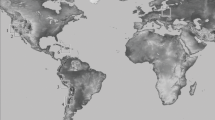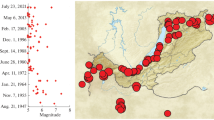Abstract
The possibility of using the dynamics of lineament systems as precursors of seismic events has been studied based on the example of strong earthquakes (M ≥ 5) in California (United States), Peru, Iran, Turkey, Transbaikalia, and Kamchatka, as well as in other regions. The pattern and time intervals of changes in lineament systems during earthquake preparation and occurrence are analyzed. It is shown that the features of changes in rose diagrams, ratios of total lengths of local lineaments (strokes) of different directions, orientation of elongation lines of rose diagram of strokes, and other characteristics that were revealed using satellite images can be used as mid- and short-term precursors of seismic events. A methodology for the automated lineament analysis of satellite images is suggested and prospects of its development for monitoring seismically dangerous areas are determined.



Similar content being viewed by others
REFERENCES
Akopyan, S.Ts., Bondur, V.G., and Rogozhin, E.A., Technology for monitoring and forecasting strong earthquakes in Russia with the use of the seismic entropy method, Izv.,Phys. Solid Earth, 2017, vol. 53, no. 1, pp. 32–51.
Baranov, Yu.B., Lyugai, D.V., and Kantemirov, I.Yu., Integrated space and geological–geophysical studies of the influence of tectonic load on the rate of use of stratum water in the Cenomanian deposit of the North Urengoi field, Perspektivy poiskov mestorozhdenii nefti i gaza v maloizuchennykh raionakh i kompleksakh (Prospects of Oil and Gas Search in Poorly Explored Regions and Complexes), Moscow: Gazprom, VNIIIGAZ, 2007, pp. 97–106.
Barsukov, V.L., Belyaev, A.A., Bakaldin, Yu.A., Igumnov, V.A., Ibragimova, T.L., Serebrennikov, V.S., and Sultankhodzhaev, A.N., Geokhimicheskie metody prognoza zemletryasenii (Geochemical Methods of Earthquake Forecast), Moscow: Nauka, 1992.
Bondur, V.G., Aerospace methods and technologies for monitoring oil and gas areas and facilities, Izv., Atmos. Ocean. Phys., 2011, vol. 47, no. 9, pp. 1007–1018.
Bondur, V.G., Modern approaches to processing large hyperspectral and multispectral aerospace data flows, Izv., Atmos. Ocean. Phys., 2014, vol. 50, no. 9, 840–852.
Bondur, V. and Kuznetsova, L., Satellite monitoring of seismic hazard area geodynamics using the method of lineament analysis, 31st Int. Symp. on Remote Sensing of the Environment (ISRSE), 2005, pp. 376–379.
Bondur, V.G. and Chimitdorzhiev, T.N., Texture analysis of radar images of vegetation, Izv. Vyssh. Uchebn. Zaved., Geod. Aerofotos’emka, 2008a, no. 5, pp. 9–14.
Bondur, V.G. and Chimitdorzhiev, T.N., Remote sensing of vegetation by optical microwave methods, Izv. Vyssh. Uchebn. Zaved., Geod. Aerofotos’emka, 2008b, no. 6, pp. 64–73.
Bondur, V.G. and Smirnov, V.M., Method for monitoring seismically hazardous territories by ionospheric variations recorded by satellite navigation systems, Dokl. Earth Sci., 2005a, vol. 403, no. 5, pp. 736–740.
Bondur, V. and Smirnov, V., Monitoring of ionosphere variations during the preparation and realization of earthquakes using satellite navigation system data, 31st International Symposium on Remote Sensing of Environment (ISRSE), 2005b, pp. 372–375.
Bondur, V.G. and Smirnov, V.M., Seismoionospheric variations during the earthquake in Pakistan (September 2005) as potential precursor of seismic events, Int. Conference on Advances in Space Technologies (ICAST 2006): Space Technologies for Disaster Management and Rehabilitation, 2–3 September 2006, Islamabad, Pakistan, 2006, AST06-108, pp. 11–15.
Bondur, V.G. and Zverev, A.T., A method of earthquake forecast based on the lineament analysis of satellite images, Dokl. Earth Sci., 2005a, vol. 402, no. 4, pp. 561–567.
Bondur, V.G. and Zverev, A.T., Satellite method of earthquake forecast based on the analysis of lineament system dynamics, Issled. Zemli Kosmosa, 2005b, no. 3, pp. 37–52.
Bondur, V.G., Garagash, I.A., Gokhberg, M.B., Lapshin, V.M., Nechaev, Yu.V., Steblov, G.M., and Shalimov, S.L., Geomechanical models and ionospheric variations related to strongest earthquakes and weak influence of atmospheric pressure gradients, Dokl. Earth Sci., 2007, vol. 414, no. 4, pp. 666–669.
Bondur, V.G., Krapivin, V.F., and Savinykh, V.P., Monitoring i prognozirovanie prirodnykh katastrof (Monitoring and Forecast of Natural Catastrophes), Moscow: Nauchnyi mir, 2009.
Bondur, V.G., Garagash, I.A., Gokhberg, M.B., Lapshin, V.M., and Nechaev, Yu.V., Connection between variations of the stress–strain state of the Earth’s crust and seismic activity: the example of Southern California, Dokl. Earth Sci., 2010, vol. 430, no. 1, pp. 147–150.
Bondur, V.G., Zverev, A.T., and Gaponova, E.V., Geodynamic features of seismic areas of Russia, based on lineament analysis, Sovrem. Probl. Distantsionnogo Zondirovaniya Zemli Kosmosa, 2012a, vol. 9, no. 4, pp. 213–222.
Bondur, V.G., Zverev, A.T., Gaponova, E.V., and Zima, A.L., Space studies of deformation wave–precursors of earthquakes manifested in the dynamics of lineament systems, Issled. Zemli Kosmosa, 2012b, no. 1, pp. 3–20.
Bondur, V.G., Garagash, I.A., and Gokhberg, M.B., Large scale interaction of seismically active tectonic provinces: the example of Southern California, Dokl. Earth Sci., 2016a, vol. 466, no. 2, pp. 183–186.
Bondur, V.G., Garagash, I.A., Gokhberg, M.B., and Rodkin, M.V., The evolution of the stress state in Southern California based on the geomechanical model and current seismicity, Izv.,Phys. Solid Earth, 2016b, vol. 52, no. 1, pp. 117–128.
Bondur, V.G., Tsidilina, M.N., Gaponova, E.V., and Voronova, O.S., Systematization of ionospheric, geodynamic, and thermal precursors of strong (M ≥ 6) earthquakes detected from space, Izv., Atmos. Ocean. Phys., 2018, vol. 54, no. 9, pp. 1172–1185.
Gufeld, I.L., Physicochemical mechanics of large crustal earthquakes, J. Volcanol. Seismol., 2008, vol. 2, no. 1, pp. 55–58.
Gvishiani, A.D., Gorshkov, A.I., Rantsman, E.Ya., Sisternas, A., and Solov’ev, A.A., Prognozirovanie mest zemletryasenii v regionakh umerennoi seismichnosti (Forecast of Earthquake Places in Regions with Moderate Seismicity), Moscow: Nauka, 1988.
Kishkina, S.B., Kocharyan, G.G., Sanina, I.A., Ostapchuk, A.A., and Shaumyan, A.V., The use of local seismic networks for identifying the seismogenic structure of faults, Izv.,Phys. Solid Earth, 2012, vol. 48, no. 3, pp. 199–210.
Kissin, I.G., Flyuidy v zemnoi kore: geofizicheskie i tektonicheskie aspekty (Fluids in the Earth’s Crust), Moscow: Nauka, 2009.
Kuz’min, Yu.O., The topical problems of identifying the results of the observations in recent geodynamics, Izv.,Phys. Solid Earth, 2014, vol. 50, no. 5, pp. 641–654.
Mogi, K., Earthquake Prediction, Tokyo: Academic Press, 1985; Moscow: Mir, 1988.
Nerserov, I.L., Perederin, V.P., Bokanenko, L.I., and Galaganov, O.N., Local deformations, Earth surface slopes and groundwater level variations in the Garm polygon in 1981–1987, Zemletryaseniya i protsessy ikh podgotovki (Earthquakes and Processes of Their Preparation), Moscow: Nauka, 1991, pp. 164–181.
Nikonov, A.A., Golotsenovye i sovremennye dvizheniya zemnoi kory (geologo–geomorfologicheskie i seismotektonicheskie voprosy) (Holocene and Modern Movements of the Earth Crust (Geological–Geomorphological and Seismotectonic Probelms)), Moscow: Nauka, 1977.
Pevnev, A.K., Earthquake prediction: Some historical aspects, Izv. Vyssh. Uchebn. Zaved., Geod. Aerofotos’emka, 1996, no. 11, pp. 24–29.
Prutskaya, L.D., Zdorov, A.G., Baturina, N.V., Krutkina, O.N., Main results of twenty-year studies on the problem of earthquake forecast in North Caucasus, Regional’naya geologiya i metallogeniya (Regional Geology and Metallogeny), St. Petersburg: VSEGEI, 2005, vol. 25, pp. 190–199.
Pulinets, S.A., Bondur, V.G., Tsidilina, M.N., and Gaponova, M.V., Verification of the concept of seismoionospheric coupling under quiet heliogeomagnetic conditions, using the Wenchuan (China) earthquake of May 12, 2008, as an example, Geomagn. Aeron. (Engl. Transl.), 2010, vol. 50, no. 2, pp. 231–242.
Seismicheskie opasnosti. Tematicheskii tom (Seismic Hazards. Thematic Volume), Sobolev, G.A., Ed., Moscow: KRUK, 2000.
Smirnov, V.M., Bondur, V.G., and Smirnova, E.V., Ionospheric disturbances during of the tsunamigenic earthquake on navigation system data, 26th Asian Conference on Remote Sensing and 2nd Asian Space Conference, ACRS-2005, Asian Association on Remote Sensing, 2005, vol. 3, pp. 1487–1494.
Sobolev, G.A. and Ponomarev, A.V., Fizika zemletryasenii i predvestniki (Physics of Earthquakes and Precursors), Moscow: Nauka, 2003.
Soloviev, A.A., Gvishiani, A.D., Gorshkov, A.I., Dobrovol’skii, M.N., and Novikova, O.V., Recognition of earthquake-prone areas: Methodology and analysis of the results, Izv.,Phys. Solid Earth, 2014, vol. 50, no. 2, pp. 151–168.
Vladimirov, V.A., Vorob’ev, Yu.L., and Osipova, V.I., Prirodnye opasnosti Rossii: prirodnye opasnosti i obshchestvo (Natural Hazards of Russia: Natural Hazards and the Society), Moscow: KRUK. 2002.
Zlatopol’skii, A.A., New capabilities of the LESSA technology and analysis of the digital relief model: Methodical aspect, Sovrem. Probl. Distantsionnogo Zondirovaniya Zemli Kosmosa, 2011, vol. 8, no. 3, pp. 38–46.
Zverev, A.T., Comparing the results of lineament analysis of apace imaging and digital relief model, Izv. Vyssh. Uchebn. Zaved., Geod. Aerofotos’emka, 2014, no. 2, pp. 96–99.
Funding
This study was supported by the Ministry of Science and Higher Education of Russia under state assignment no. 075-00896-19-00.
Author information
Authors and Affiliations
Corresponding author
Additional information
Translated by D. Zabolotny
Rights and permissions
About this article
Cite this article
Bondur, V.G., Zverev, A.T. & Gaponova, E. Precursor Variability of Lineament Systems Detected Using Satellite Images during Strong Earthquakes. Izv. Atmos. Ocean. Phys. 55, 1283–1291 (2019). https://doi.org/10.1134/S0001433819090123
Received:
Published:
Issue Date:
DOI: https://doi.org/10.1134/S0001433819090123




